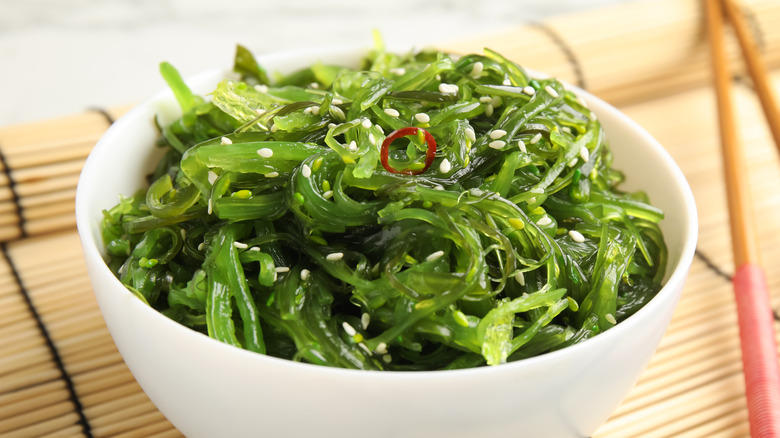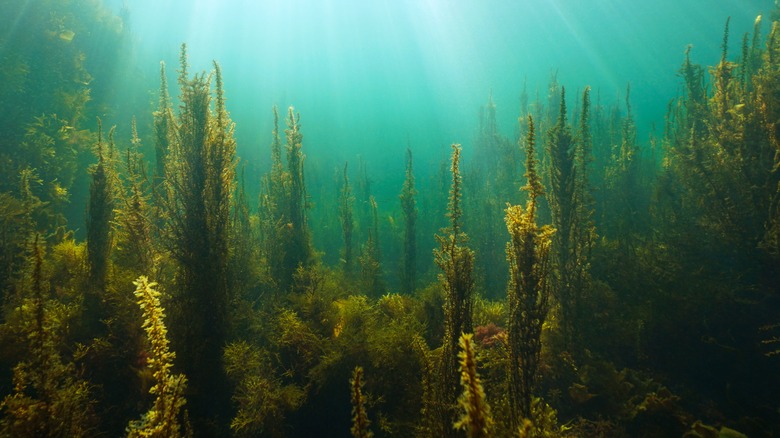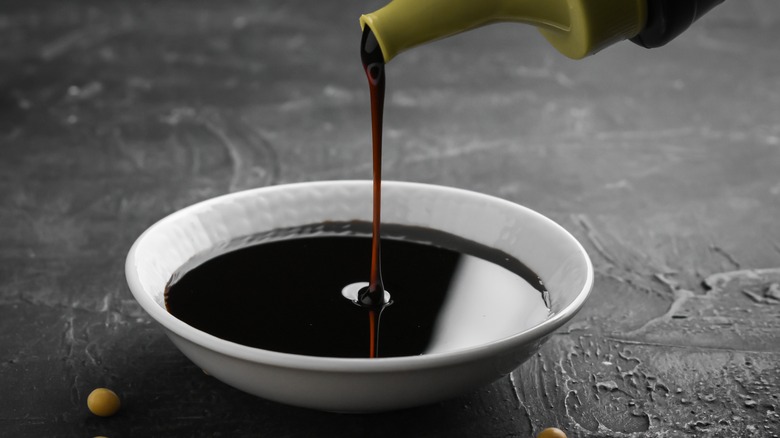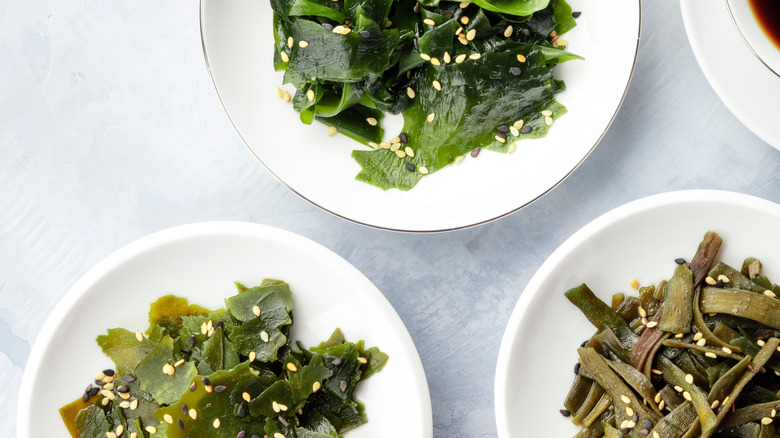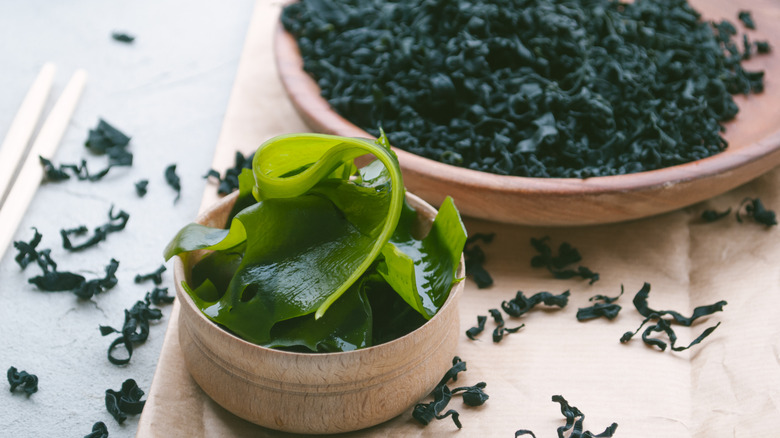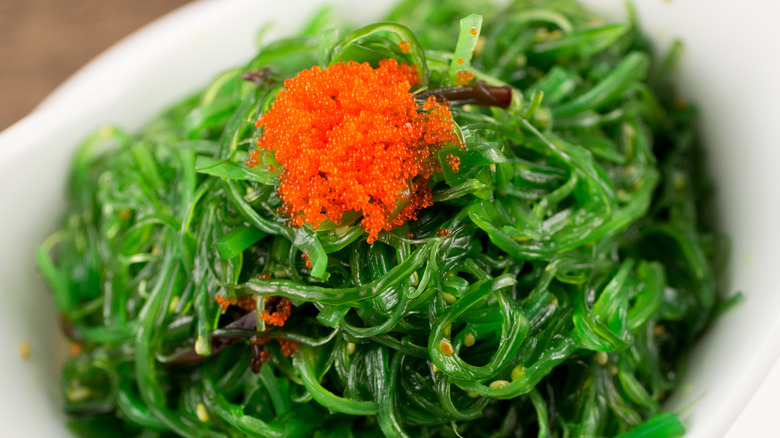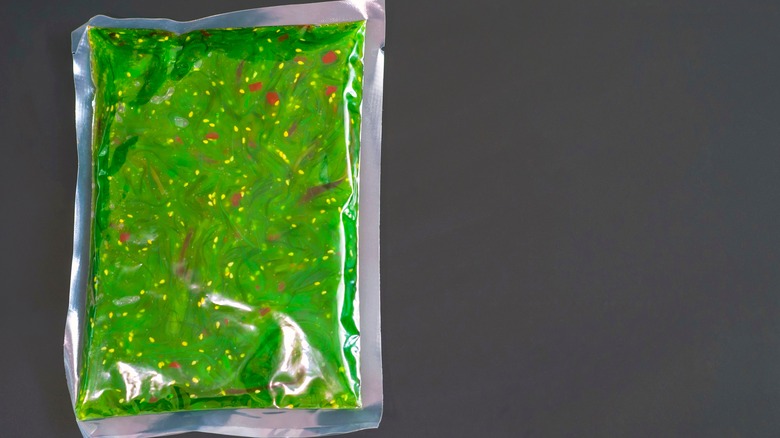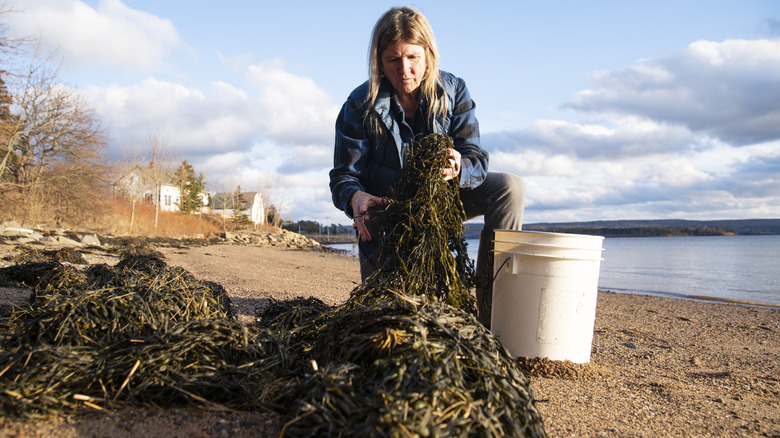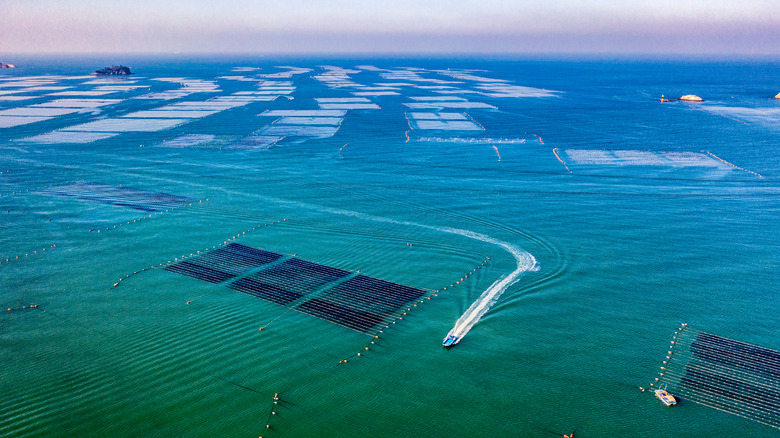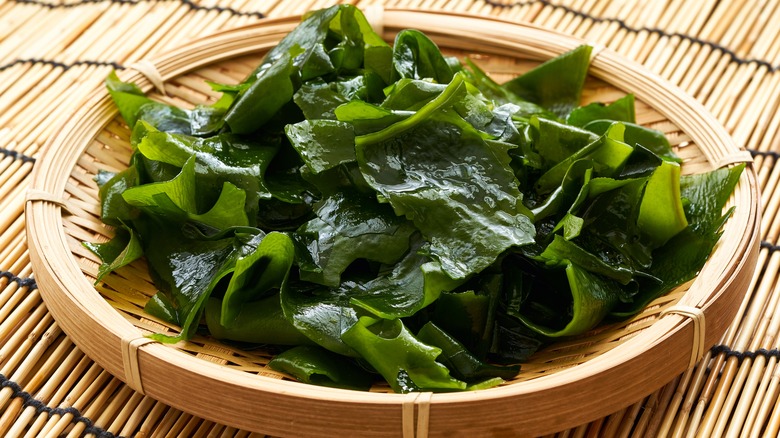The Fascinating Origins Of Japanese Seaweed Salad
It's no secret that seaweed salad has exploded in popularity. And why shouldn't it? Regarded by many as a "superfood," this oceanic vegetable tends to be low in calories and high in nutrients (via Time). According to Mary Ellen Camire, CFS, Ph.D., some of these nutrients include vitamin B, proteins, and plenty of omega-3 fatty acids. Carmire, who works as a professor of food science at the University of Main, told CNN that "seaweed is an excellent source of dietary fiber and minerals." She also added that certain types of brown kelps, like New England's sugar kelp, "are very high in iodine."
Because of seaweed's beneficial health properties and complex flavors, this ingredient has long been a favorite in Japan. There, people have been known to prepare nutritious seaweed salads for centuries — and have encouraged their children to pass this tradition down to future generations. These days, many seaweed salads are made by soaking their ocean-based veggies in either vinegar or ponzu sauce and serving them cold as a side dish. However, in the past, people would use the oceanic vegetation for ceremonial purposes as well.
Consequently, seaweed salad has a rich history that has resulted in many different versions of the dish. In Japan, varieties include simple plates of raw algae and even tender seaweed blossoms paired with sweet yams. But, on an international level, these salads have inspired some interpretations that are more authentic than others.
Seaweed salad has ancient Japanese roots
Although it is difficult to pinpoint at what point Japanese people started eating seaweed salad, we do know that Japan has a long history of preparing these oceanic veggies. As explained by the Japanese seaweed education company, Riken Vitamin, there is some evidence that wakame sushi has been consumed in the region since the Jomon period (6000 to 300 B.C.E.). Indeed, when pottery from the era was uncovered at the Kamegaoka ruins, wakame remains were reportedly discovered along with it.
By the year 701 B.C.E., it seems, seaweed had become deeply valuable to the Japanese people. According to Hiroya, it was in this year that a Japanese legal code, known as the Taiho Ritsuryo Code, stipulated that people could pay their taxes in the form of seaweed. Nori was actually one of the main types of seaweed that qualified as payment, although laver was also included on the list. These sea vegetables were considered valuable at the time due to their popularity among the Japanese elite.
Interestingly, during this same era, references to seaweed began appearing in Japanese poetry. The "Manyoshu" text, which was written in the 8th century, discusses this ingredient in a poetic way. One poem even discusses the ingredient as a metaphor for survival and sustenance, reading, "Clinging to this transient life / I live on the seaweed / which I, drenched with the waves / Gather at the Isle of Irago."
Seaweed had ceremonial purposes in Japan
As evidenced by its appearance in 8th century Japanese poetry, seaweed has long held a strong cultural value in the Land of the Rising Sun. However, the ingredient's significance has traditionally spanned beyond literary value. In fact, in some regions of Japan, seaweed farming has been regarded as a spiritual process. As revealed by the Japanese Food Guide, people have harvested wakame as a part of a Shinto ceremony for centuries. Legend has it that this ceremony, known as "Mekari Shinji," dates as far back as the year 710 B.C.E.
As a part of "Mekari Shinji," a trio of Shinto priests gathers on the lunar New Year, wearing ceremonial attire (via Visit Fukuoka). Carrying a three-meter long torch, they then march into the ocean and dunk themselves in the freezing water. Once they are adequately wet, the priests begin to harvest stalks of wakame, piece by piece. They ultimately take their seaweed to an altar, placing it there as an offering.
This tradition, which continues to be practiced to this day, demonstrates just how sacred seaweed was to Japanese people long ago. Of course, it reveals that the consumption of this food group was important, long before the rise of contemporary seaweed salads. However, more than that, this history shows that the modern seaweed salad can trace its origins to a centuries-long tradition of valuing this unique ingredient.
One of the most essential seaweed salad ingredients comes from China
Although seaweed has been an integral part of the Japanese culinary tradition for hundreds of years, seaweed salad can trace some of its history back to China. After all, modern seaweed salads are often made by dressing algae in soy sauce — a condiment that originally came to Japan via China. Indeed, as noted by SoySauce.or.jp, the people of ancient China used "jan," or a soy sauce predecessor, to pickle their vegetables and preserve them over long periods of time. In 1254, a zen priest by the name of Kakushin brought this concept from "The Red Dragon" to Japan in the form of miso paste. When Kekushin's contemporaries attempted to replicate this recipe, they accidentally created a brownish liquid now known as soy sauce (via Japan Travel).
These days, soy sauce continues to be served on vegetables, although not necessarily with the intention of preserving them. When it comes to Japanese seaweed salads, the condiment mostly serves to flavor the greens with a burst of tangy goodness. That being said, the origins of soy sauce have not been forgotten by wakame salad lovers. Some people in Japan even refer to this dish as a "chuka" (or Chinese) salad for this very reason. Speaking to the New York Times, Devan Nielsen, who once worked at the salad company Azuma, explained, "Even though the Japanese use soy, they still credit the Chinese with inventing it."
Various seaweed salad dishes are eaten in Japan
Partially due to the rich history of seaweed salad, there are many different ways to prepare this dish. As reported by Nippon, there are over 100 different types of edible seaweed to be found on the Japanese coast, each with its own flavor, texture, and properties. Thus, over time, Japanese cooks invented unique ways to prepare each of these delicacies.
Of course, this means that different types of seaweed salad quickly found their way into daily life. As Osaka native, Chizuko Nishimata, told the New York Times, one can find this unique dish just about anywhere in Japan: "Everybody eats seaweed salad, as an appetizer, with sake or beer, as a snack, like bagels. It's so good, even my American friends who say they won't eat seaweed love it."
One of the most popular types of seaweed salad uses mekabu, which is a tender cut of the wakame plant. Succulent yet slick, mekeabu is often dressed in ponzu sauce and then served in a salad with Chinese yams. In this delightful combination, the acidity of the ponzu sauce contrasts with the natural sugars of the yams to create a salad that is both flavorful and balanced. Mozuku seaweed is also said to be popular in Japan, although it tends to appear in more elaborate salads alongside sweet carrots, salty soy sauce, and pillowy tofu. Meanwhile, umibodou seaweed pearls are often served straight up with no fixings.
Seaweed salad has grown popular on an international level
Although seaweed salad originated in Japan, this delightful dish is consumed all over the world. Starting in the 1990s, big cities, like New York, faced rising demand for this vegetarian item. In 1997, The New York Times reported a boom in this menu item, even outside of Japanese restaurants. Indeed, the outlet found that seaweed salad began to appear at Chinese, Vietnamese, and French eateries as a result of high client demand. As seafood store owner, Colin Mather, told the Times, "We started carrying it this summer because of customer request. We're selling a huge amount."
Interestingly, following the initial seaweed salad boom, the dish only seemed to grow more popular. During the early 2000s, it became a staple at Japanese restaurants in Italy and other parts of Europe. It also maintained a steady increase in popularity across the United States. This was especially evident during the 2018 National Restaurant Association Show, where Professor James E. Griffin gave a talk called "See Sea Vegetables." As described by Nation's Restaurant News, Griffin shared, "Sea vegetables in the higher level of dining have been growing rapidly over the past 10 years — and over the past three incredibly fast." In 2018, it was estimated that the dish experienced a 7% annual rise in popularity.
The type of seaweed salad eaten abroad is different from the Japanese version
Even as seaweed salad has gained popularity outside of Japan, it is important to note that the versions enjoyed abroad are very different from the traditional Japanese iterations of the dish. For one thing, the international versions of seaweed salad tend to use wakame seaweed, rather than the rich diversity of vegetation that you might find on your plate in the Land of the Rising Sun.
For another, the dish that is found in the U.S. and Europe is often flavored more than the authentic version. As Devan Nielson of the seaweed company, Azuma, told the New York Times, "The seasonings have been pumped up a little for Americans — a bit more red pepper and soy. We like our food spicier than the Japanese."
That being said, the biggest difference between Japanese seaweed salads and international interpretations of this dish lies in the level of processing. According to Kiwi seaweed expert, Peter Langlands, the type of seaweed salad found outside of Japan is not exactly freshly harvested. Speaking to Stuff about these salads, Langlands shared, "They are so processed, they are crap ... That green spaghetti-like seaweed you see in pottles in the supermarket is made from the base of the wakame and it is finely shredded. They add a lot of food dyes to them and they are heavily processed with heat."
The seaweed salad sold outside of Japan tends to be highly processed
Because of the addition of artificial dyes and coloring, the type of seaweed salad found outside of Japan is not as natural as one might believe. As revealed by a report in The New York Times, many restaurants do not serve their own "house-made" seaweed salad, instead opting to buy prepackaged or frozen versions of this dish. This results in salads that aren't necessarily good for you. In a conversation with Vice, Milan-based chef, Jun Giovannini, shared her opinion that seaweed salad "is not even healthy, contrary to what people might think, because of how it's processed with dyes before being sold."
Regardless of the veracity of that statement, one thing is clear: The interpretation of seaweed salad sold in most Asian-themed eateries is not fresh. In fact, some of it is processed and packaged in factories in China, before being shipped to restaurants all over the world. One only needs to glance at the Chinese supplier website, Made in China, to perceive how common this is. The site, which offers to connect Chinese sellers to bulk buyers abroad, advertises more than a dozen companies that sell prepackaged versions of seaweed salad. Many of the suppliers promote their frozen salads as being "ready to eat" as soon as they thaw out.
International seaweed farming has exploded due to the popularity of this salad
While some seaweed salads are highly processed, plenty of gourmet eateries make their own versions of this dish. And, as this delicious salad has steadily increased in popularity, the demand for seaweed farms has exploded. In 2019 alone, Alaskan seaweed farms collected 112,000 pounds of this unique crop — marking a 200% increase from their initial 2017 harvest (via National Oceanic and Atmospheric Administration). Before that, seaweed, like kelp, was not even farmed commercially in the state. However, the industry has quickly taken off. These days, Alaska is already home to the largest kelp farm in North America.
And Alaska is not the only region that has undergone a seaweed farming boom. Galicia, a maritime region in Northwestern Spain, has also seen an increased interest in harvesting this type of vegetation. There, the "Ría de Arousa," or "Arousa Fjord," is rich in seaweed, a fact which has motivated the Spanish Ministry of the Sea to investigate the best way to grow this industry.
What's more, the increasing popularity of seaweed salad in Galicia has also raised overall curiosity about using this ingredient in other ways. As seaweed processor Cristina García told the local outlet, La Voz de Galicia, "On a general level, we can say that the interest in introducing seaweed into our diets is increasing."
Eating seaweed salad has been touted as a solution to climate change
As seaweed farming has become more popular, the environmental benefits of this type of crop have become more evident. According to the National Oceanic and Atmospheric Administration, "seaweeds are incredibly efficient at sucking up carbon dioxide and using it to grow." This means that these greens can help pull dangerous greenhouse gases out of the atmosphere. This incredible type of vegetation has also been known to eliminate nitrogen and phosphorous from large bodies of water.
As a result, eating more seaweed salad and, therefore, supporting seaweed farming can have a positive impact on global warming. After all, we can count on seaweed farms to provide huge benefits to the environment. One of the biggest ones, per the National Oceanic and Atmospheric Administration, is the prevention of oceanic acidification. The government organ also maintains that seaweed farming can prevent the ocean from forming "dead zones."
An added bonus is that, unlike forests, seaweed farms exist in the water rather than on land. Consequently, the areas used for seaweed production do not interfere with other needs, like housing or public spaces. According to Katie Lebling of the World Resources Institute's carbon removal team, this is one of the primary benefits of increasing our seaweed consumption. Speaking to Time, Lebling explained, "When we're planting trees, we need to make sure it does not take away that land from food production. But that is not an issue with seaweed."
Preparing your own seaweed salads can help you reap this dish's benefits
Even though some types of seaweed salad are highly processed, the natural version of the food can have major benefits, both for the human body and for Mother Earth. Thus, you can try to maximize the positive impact of the dish by making it at home. For one thing, making your own seaweed salad will give you the opportunity to enjoy a final product that is not processed.
To ensure that you are supporting the environment, try looking for seaweed that is produced at least somewhat locally. This will allow you to support an eco-friendly seaweed farm, rather than a large food processing company in a faraway country, like China. It will also give you the chance to procure seaweed that is actually fresh, as opposed to a product that has been frozen for months.
When you get ready to make your homemade seaweed salad, feel free to add whatever veggies you want. Sliced cucumbers and carrots can add a bit of crunch to your salad, while the addition of diced sweet potatoes or yams can make it meatier. You can even add grains, like quinoa or noodles, to your seaweed salad to transform it into a meal. In this Asian pasta salad, orzo, edamame, and seaweed mingle to create a dish that is savory and filling.
